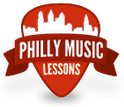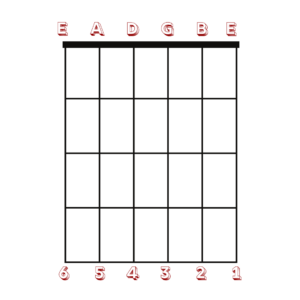
3 Easy One String Guitar Riffs Every Beginner Should Know
Learning guitar can feel like a huge challenge when you’re just starting out, but there’s one thing that can make it exciting: playing a recognizable riff. Mastering a few easy guitar riffs, played on just one string, will not only boost your confidence but also help build essential finger strength, coordination, and rhythm. To help you get started, we’ve rounded up three beginner-friendly guitar riffs that you can learn right away!
A little background on the basics before we get started:
A standard guitar has 6 strings, and each one is assigned both a name and a number. For example, ‘the A string’ is also known as ‘the 5th string.’ These terms are often used interchangeably. The chart below illustrates (from thickest to thinnest string) the assigned names and numbers for each string – beginning with the 6th and thickest string, the Low E String.
When you play any of the 6 strings without pressing on the fretboard, they’re called ‘open strings’ or referred to as fret 0.
Frets are the small metal strips embedded in the fretboard. It’s simple: the first fret is the metal strip closest to the guitar’s headstock, followed by the second, third, fourth, and so on as you move up the neck and towards the body of the guitar.
Now that we have laid some super basic groundwork, grab your guitar and let’s dive into these classic tunes!
1. “Smoke on the Water” – Deep Purple
- Difficulty: Easy
- Fretboard Position: 0, 3, 5, 6
- String: Low E
“Smoke on the Water” is one of the most famous beginner guitar riffs of all time, and for good reason. With just four notes, this riff is simple enough for any beginner to pick up quickly. The main riff is played on the low E string, and you can practice it at a slow pace before speeding up.
How to play it:
- Start by plucking the open low E string.
- Then hit the 3rd fret..
- Play the 5th.
- Back to 0 (or, open low E string)
- Back to 3rd fret
- Down to the 6th fret
- Back to the 5th fret
- Back to 0
- Back to 3
- Back to 5
- Back to 3
- And end on 0
- Repeat this pattern to play along with the song!
Play Pattern:
0-3-5-0-3-6-5-0-3-5-3-0
2. “Seven Nation Army” – The White Stripes
- Difficulty: Easy
- Fretboard Position: 7,10,5,3,2
- String: A
The riff from “Seven Nation Army” by The White Stripes is incredibly recognizable, and it’s also one of the easiest riffs to learn. Played on a single string (the A string), this is a perfect riff for those who want to play something powerful with minimal effort.
How to play it:
- Start on the 7th fret of the A string and pluck it twice.
- Move up to the 10th fret, Back down to the 7th, then the 5th, 3rd, and finally the 2nd fret.
- Add the rhythm, and you’ll be playing along in no time!
Play Pattern:
7-7-10-7-5-3-2
3. “Iron Man” – Black Sabbath
- Difficulty: Easy
- Fretboard Position: 7,10,12,15,14
- String: Low E
If you want to feel like a rock star right out of the gate, “Iron Man” by Black Sabbath is the riff for you. This heavy, slow, and simple riff is great for building confidence and (eventually) practicing power chords.
How to play it:
- Start by plucking the 7th fret on the Low E string.
- Move up to the 10th fret, then hit it twice.
- Down to the 12th fret, pluck twice
- With your your middle and index fingers, alternate between the 15th and 14th fret
- Back to the 10th fret, plucked twice
- And finally, the 12th fret, also pluck twice
- Play it slowly and deliberately to mimic the song’s iconic feel!
Play Pattern:
7-10-10-12-12-15-14-15-14-15-14-10-10-12-12
Tips for Practicing Guitar Riffs
- Start Slow: Don’t rush to play these riffs at full speed. Start slowly to ensure accuracy, then gradually increase your speed as you get more comfortable.
- Use a Metronome: Staying in time is critical when learning riffs. Using a metronome (or a metronome app) will help you develop a sense of timing and rhythm.
- Play Along with the Song: Once you’ve nailed the riff at a slow pace, challenge yourself by playing along with the original track. This is a great way to develop your musical ear and build confidence.
- Record Yourself: Listening back to your own playing can help you identify areas to improve and celebrate your progress.
Ready to Learn More? Sign Up for Guitar Lessons Today!
Now that you’ve mastered these riffs, why not take the next step? At Philly Music Lessons, our experienced guitar instructors are ready to help you deepen your skills, whether you’re just starting out or looking to improve your technique.
Sign up for a free trial lesson today and let’s rock!
Philly Music Lessons offers guitar lessons for all levels in Philadelphia. Our personalized approach ensures you get the most out of your learning experience. Contact us today to schedule your lesson!




